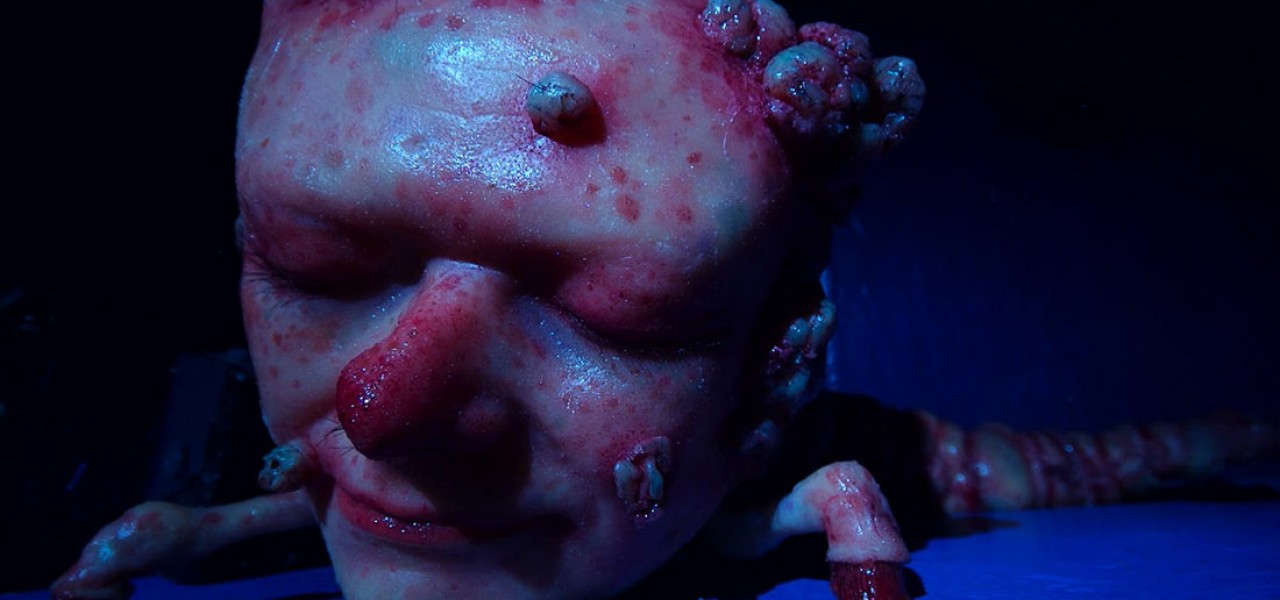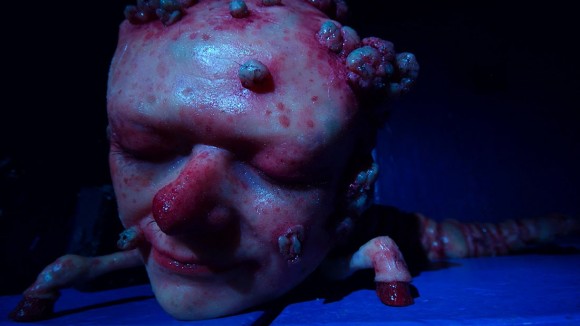

The Art of Animating Horror: An Interview with Robert Morgan
For two decades, British animator Robert Morgan has created a body of work characterized by nightmarish stop-motion.
Influenced by the horror of Francis Bacon, Edgar Allen Poe, and the Brothers Quay, Morgan’s animated shorts like The Cat with Hands and The Separation are disorienting trips into the subconscious. His uncompromisingly confusing 2011 short, Bobby Yeah, was rewarded with a BAFTA nomination, among numerous other honors.

Cartoon Brew sat down with Morgan during his retrospective at the Animateka festival last month in Ljubljana, Slovenia, for an in-depth interview about the power of animation as an imaginary realm, the appeal of the gruesome Bobby Yeah, and why his real dreams are actually quite boring — which is unhelpful in his line of work.
Cartoon Brew: What is it about stop-motion that you love so much?
Robert Morgan: As a kid, I always found stop-motion creepy. I love horror and making nightmarish films, and stop-motion animation is perfect for that. The way everything moves has an unnatural, uncanny feeling, a weird jerkiness. Everything is somehow alive and dead at the same time.

Building tension is a large part of your work. How do you do it?
Robert Morgan: When you establish something, there is a certain expectation in the audience for what happens next. So my job is to simultaneously satisfy that expectation, but deliver in a slightly different way. The audience more or less knows what’s going to happen, but it turns out to be not exactly what they thought. It’s about creating a threat to hang over each scene.
With horror, it’s important to decide what to show and what not to show. How do you make those decisions?
Robert Morgan: Some things are more powerful unseen, and some things are more powerful when they are seen. It depends on the thing that you’re suggesting. When it’s something mundane, like a man following you down the street, we all know what a man looks like, so you don’t need to show him. But when it’s something very specific that the audience has never seen before — like the scene in David Cronenberg’s Videodrome, where a videotape is inserted into a sexual opening in the stomach of the main character -– well, as Cronenberg himself said, how do you suggest that? You’ve just got to show it.

You direct animation and live-action films. What do you perceive as the main difference between them?
Robert Morgan: In a way, audiences read live-action differently from animation. In my live-action films, I need a certain credibility to make them work. Whereas in animation, credibility is unimportant; in fact, incredibility is better. With animation, there’s already a distance; that’s not a person you’re looking at, it’s a symbol of a person. That distance allows me to express things in a very different way from live-action. If the events in my animation happened to real actors in a gritty, realistic way, I couldn’t imagine people actually enjoying my work in the same way. Animation allows you to experience and enjoy stuff because it is too indirect to be truly hurtful. It’s a kind of almost abstract violence.
Your work is about violence and nightmares, but also quite emotional.
Robert Morgan: That’s true, but it’s a very primal kind of emotion — and that’s exactly what animation is really good at. I always think of my characters as extremely basic organisms. The things they want and need are very basic, which is why my characters are often reduced to worms and maggots. They are simple, primal organisms with simple, primal urges.
However, this doesn’t mean my characters can’t evoke complex emotions in the viewer. It just means that they are not complex. People find the main character in Bobby Yeah to be quite ambiguous. They kind of like him, but he’s ugly and violent, although he’s also sort of cute and tender as well. He evokes all of those different emotions, even though he is just a basic organism.
Do you regularly have nightmares?
Robert Morgan: On the contrary, my dreams are extremely boring. I dream about things like doing the dishes. It’s unfortunate, really. Having nightmares would make it so much easier for me to come up with ideas.

Bobby Yeah makes one face during the whole film, which is a unique filmmaking choice.
Robert Morgan: I made my very first student film out of papier-mache, and I didn’t know how to animate a facial expression with that. More importantly, I couldn’t really imagine what expressions he would have other than afraid. The film was about a character having a nightmarish experience, so what else would he be doing? He’s not going to be smiling, is he? Afraid is his only mood, so I left it at that. It worked, so I’ve been doing it since.
Doesn’t a fixed expression restrict your storytelling or acting?
Robert Morgan: Actually, I found it to be the opposite. It opens up the character, and allows the viewer to project onto it. Have you ever seen a beetle struggling to push massive mountains of rabbit poo, or something? You feel his struggle, right? The beetle doesn’t need to be gritting his teeth; you can feel it through his performance, and the context.
During your Animateka retrospective, you said Bobby Yeah’s process was entirely improvised from start to finish. No synopsis, script, or storyboard.
Robert Morgan: I spent a long time writing scripts with lots of rationalizing and analyzing, and asking what everything meant all the time — and I was just really bored of that. I wanted to see what would happen if I created a strong character, and a world for him to move around in, and what that would suggest to me. I’d animate a bit, then edit and watch the film from the beginning up to the new bit; then I’d ask what could happen next. The great thing about this process is that I was never thinking where it was going. At any point, anything could happen. I’ve tried to be really open to that.
If you write a script, you start becoming very rational. That has its uses, and I’ve made films like that, but my goal for Bobby Yeah was to make a film where the concept of analysis is just a joke. I wanted the film to feel like a dream, stream-of-consciousness, completely unpredictable. And the best way for me to be unpredictable is basically to not have any idea what I’m doing. [Laughs] If I didn’t know where it was going, if I was surprising myself about what would happen next, then surely the audience would feel the same. That was my theory.
Bobby Yeah is 23 minutes long. How do you keep the audience interested when they have no idea where the film is going?
Robert Morgan: The character, and his performance, takes you through, particularly when Bobby Yeah is confronted with those red buttons. The audience becomes Bobby when he wants to press the button, and knows something terrible might happen, but he can’t stop himself. It’s that push and pull that the audience can relate to. The audience doesn’t necessarily like him, but they understand him.
You used to sell Bobby Yeah online. How did that go?
Robert Morgan: The income was kind of OK, but not nearly enough. To be honest, I kind of gave up on selling shorts online. I used to sell Bobby Yeah for just 99 cents, for which you could stream and download the film — and people were still pirating it. They just wouldn’t pay, but there’s really no use complaining. It’s just the way it is. I’d rather have people see my work, than not.
European shorts are mostly made through state funding, but there’s none in Britain anymore. Are you still able to make your shorts?
Robert Morgan: The thing is — and this is part of the reason why I made Bobby Yeah — when real funding stopped being available, I realized I had to make a decision: either I just don’t make films anymore, because there is no funding, or I stop complaining about it and, you know, make something! It’s hard work, but the idea of not doing it is too depressing. Deciding not to be a filmmaker anymore is not an option.
For me, the trick is just to make shorts on really low budgets. But actually, if you compare Bobby Yeah’s cost, like £3,000, to The Separation’s £70,000 budget, you see there’s not a big leap in terms of quality. The only difference is I can’t live off of it. I’m supporting myself through part-time teaching.
Did you consider commercial work to support yourself, instead of teaching?
Robert Morgan: I’d like to do commercials, but it’s hard to imagine what I would sell with my style. I mean, really, what would it be? Maybe some public information-type of film, like an anti-smoking advert. Rather than using my style to sell something, using it to warn people about something. Actually, now that I think of it, I could imagine people asking me for that sort of thing.
Dumb Ways to Die, Robert Morgan-style?
Robert Morgan: Yes, with stop-motion animated blood and slime! You know, I wouldn’t turn that down.
Why do you think people enjoy your shorts?
Robert Morgan: I don’t know, actually … it’s bizarre. But I like my films. And my rationale is that if I like them, for whatever reason, there must be others liking them as well. Because contrary to what people may think, I’m actually a very normal person.
What’s next for the very normal Robert Morgan?
Robert Morgan: I’ve been developing three feature films over the past few years. This year, I’m going to push all of those forward, and hope one of them gets some traction, funding-wise. Weirdly, there’s more prospect to make a feature film in Britain than a short, because at least you can sell a feature, which makes it easier to get funding. But the downside to features is they — or at least mine — require a certain budget, so it can take quite long to gather the necessary funds.
I’m hopeful, but it’s really easy to get disappointed by these things. That’s why I’m also going to start working on a new short film of my own, to keep myself sane. I might try and do another film like Bobby Yeah. It’s a really fun way of making a film: Just entertaining yourself, because you don’t know what’s going to happen next.
